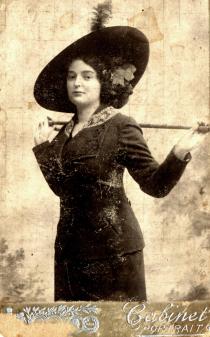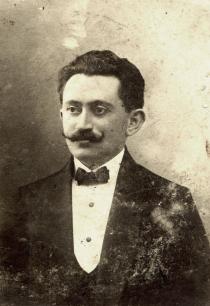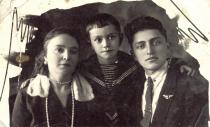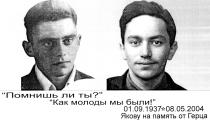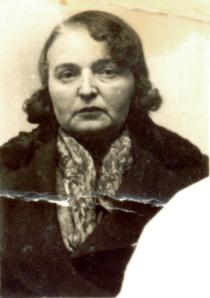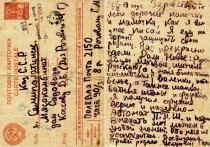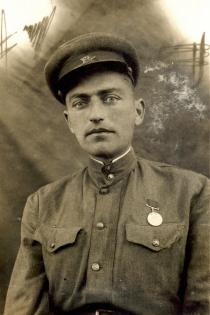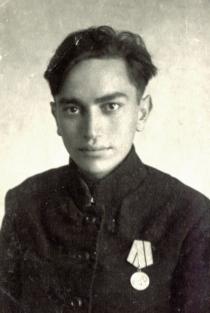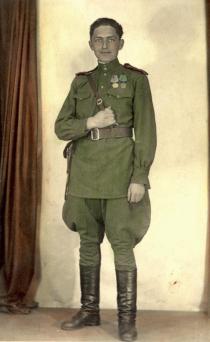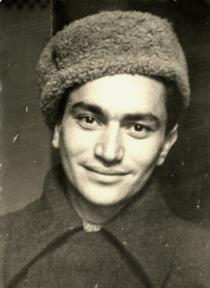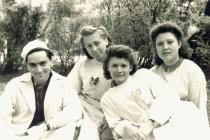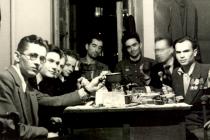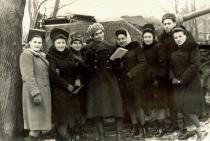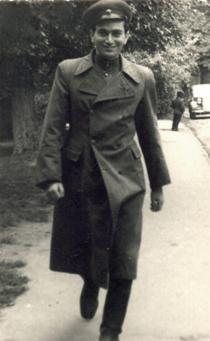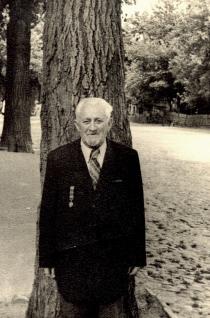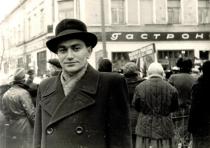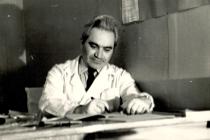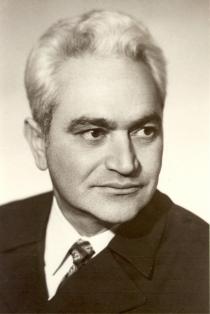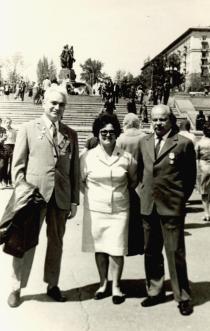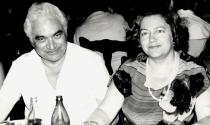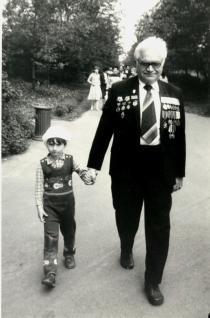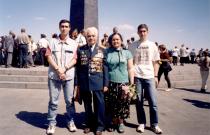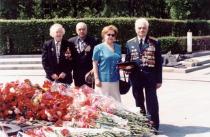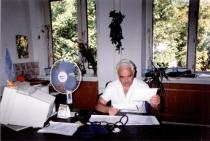These are my fellow-students. I, Hertz Rogovoy am in the center. The picture was taken in the institute park after we had passed the last exam in 1948 in Kiev. The girl wearing a white kerchief on my right is Mira Stillman from Kiev, born in 1925, she was a physician, lives in Kiev, during the Great Patriotic War she evacuated to Ufa, beside her Liudmila Prihodko. On my left is Lilia Triger, evacuated to Kazakhstan during the Great Patriotic War. The guy on my left is Alexandr Shakenov - Pogrebitskiy, a former infantry guy, invalid of the war grade II (was wounded in his arm, had bones broken and nerves affected), physician, he may have passed away. I remember nobody else.
In the winter 1943 near Kursk was my last fight, I was wounded, and sent to the hospital. In August, 1944 I entered the Kiev Medical Institute. All those years I got excellent marks. Of course it was difficult. I had been walking on crutches for all those years. Often my wound was open, and the splinters were coming out, causing acute pain. Of course I was young, and I wanted to appear a hussar in front of girls, and leave the crutches. I made a stick with a handle myself so I could prop on it with both hands. I had used by the fifth year. At that time I was able to walk, not only without a crutch, but even without a stick. There were 850 ladies and 40 men in my graduation year. Those guys were mostly handicapped like me. Those who were healthy then in 1944, were at war. There were armless and legless people among us. I entered psychoneurotic department. I had studied there for years. Then it was closed down, and I became a therapist. There was no other way out.
I was given a room in the hostel of the medical institute. The handicapped in war were given the whole floor. During the last courses we were given the cards for dinner. But it was later. At the beginning, we just used to starve. I being unsettled, feeling hunger and cold by all means decided to graduate from school. So, I kept on learning hanging on by skin of teeth. I was good student, remaining the monitor of the group through all students' years. The clothes that I had was ill-kemp- my military uniform from war. I wore military jacket, received at war in 1941. I never took off my jacket, even during the classes, because my army pants were torn on the back side, and on the knee area. I was not ambidextrous at that time, so with my left hand I sawed patches made from my green tunic on my black pants. I did not have any other clothes. My parents were in evacuation. In Kiev there was only my aunt Feiga, who would rarely cook something for me. My scholarship was enough to buy the beans, the cheapest product at that time and a little bit of fat. The bread given by cards was not sufficient, 300 or 400 grams. I never could take it to the hostel from the store, I ate it on my way. I could not die. Sometimes the ration included herring and sugar, so I stood by the store and tried to exchange them for bread. In 1946 my parents came back to Kiev from evacuation. They did not have a place to stay. First they found a poky apartment for rent, and then bought it from the landlords. It was a tiny room, without conveniences, with no water and toilet. They had a hard life. They were indigent. But still I would come to see them and take the pot luck with them, no matter how skimpy it was. My brother came from the front twice and made great feasts for me. First he came in 1945, brought me new uniform - English boots, uniform and pants. When I saw a hen on the table, I burst into tears. Tears were streaming from my eyes, and I am not a susceptible and a mawkish boy. I practically did not have any other food, but bread. And I was not willing to eat anything else but bread. Then as a doctor I found out that a hungry person craved for bread more than for meat because of lightly digested carbohydrates. And during my student's years I would have survived without faith. Of course I did not divulge it, but in God was always in my soul.

